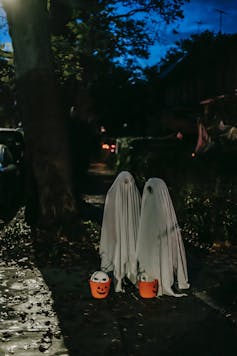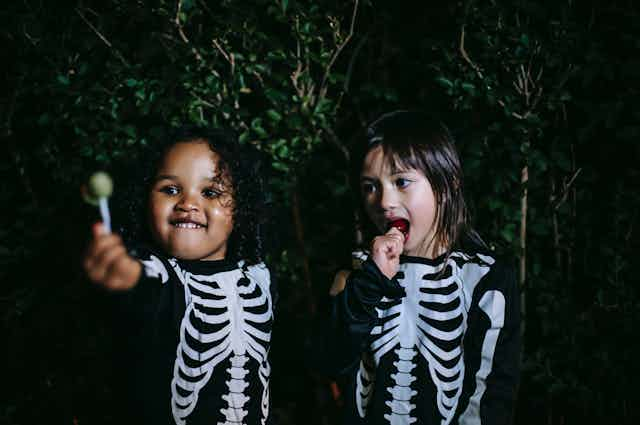Halloween is a very exciting time for children and let’s face it, for many adults, too.
The costumes, decorations and of course the treats all contribute to the thrill of this spooky holiday. However, as parents and dietitians who research children’s eating, we often find ourselves grappling with the challenge of the avalanche of sugary treats.
Depending on how much your children collect on the night, the lollies can hang around for days or weeks.
Balancing our children’s enjoyment of treats with their health can be a challenging task, but there are strategies to help.
Read more: Dressing up for Halloween? You could be in breach of copyright law, but it's unlikely you'll be sued
A balanced approach to sugar
The food your child eats over the whole year is more important than the foods they eat in one day or week of the year.
As part of promoting healthy eating, it’s important not to demonise sugar but teach your child it can be consumed as part of a healthy diet. This balanced approach can help children develop a healthy relationship with all foods.
Guilt and shame around eating certain foods can disrupt normal eating patterns.
A positive relationship with food means you give some thought to food selection so you get nutritious food but aren’t so wary and restrictive that you miss out on enjoyable times. Food and eating take up some of your time and attention, but keep their place as only one important area of your life.
You can encourage a healthy relationship with food by:
avoiding the ‘good’ vs ‘bad’ label: instead of labelling foods, focus on moderation and variety. Teach your child it’s okay to enjoy treats and fun foods occasionally and they don’t need to feel guilty about it.
modelling healthy habits: children learn by example, so be sure to model healthy eating habits yourself. Show them you enjoy a range of foods without guilt or shame.

How can you have a healthier Halloween?
Halloween is a time of celebration and fun. It can also be an opportunity to promote eating in a positive and balanced way. Here are some ideas:
have a filling meal before you head out: a full stomach means kids are less likely to fill up on lollies. Having only lollies for dinner will lead to a sugar crash and leave children hungry and cranky at bedtime
give your kids child-sized baskets: a smaller container can limit the number of lollies your child collects and eats. Encourage them to take only one piece from each house, promoting moderation and helping kids understand there needs to be enough left over for other children
keep active: incorporate physical activity into your Halloween celebration. Perhaps you have a long walk around your neighbourhood, so you get exercise while you trick or treat. Or you could have a zombie dance party when you get home. These activities can help your child shake out their sillies from the excitement of the night
have treats on hand that are not lollies: the Teal Pumpkin Project (led by Food Allergy Research and Education) celebrates Halloween with non-food treats and supports kids with food allergies who may not be able to have typical Halloween lollies. Instead of lollies, you could have stickers, glow sticks, pens and pencils, bubbles or small toys.
What about all the leftover lollies?

Some kids get to the end of Halloween evening and have an enormous haul of lollies they cannot possibly eat – even if they would like to try.
So it’s a good idea to have a “leftover lolly plan”.
Decide how many lollies your child can keep and what to do with the excess. As a general guide, you should stick to one-to-two fun-size treats a day for three-to-eight-year-olds and one fun-size treat a day for toddlers two-to-three years.
But on Halloween, it’s likely they will have more than this. Don’t stress too much and remember it’s only one night of the year. But please note babies under 12 months can choke on lollies and don’t need to have them.
For older children, consider donating some to food banks or sharing their haul with their peers at school or sporting clubs. You could also trade excess lollies for other rewards like toys or activities. Or parents could “buy” the lollies in exchange for more pocket money.
You could even create a homemade advent calendar with Halloween lollies leading into Christmas.

